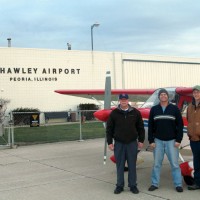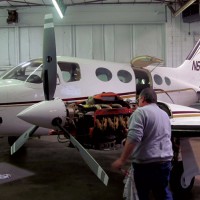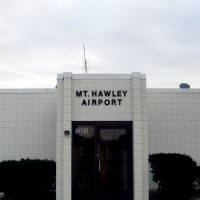Voices
Mt. Hawley Airport
- Details
- Published on Sunday, 01 January 2012 16:06
- Written by Paul Gordon
Runway expansion likely to lead to more business in future
To the naked eye and ear, the improvements ahead for Mount Hawley Airport on Peoria's northern edge probably won't be noticeable. The planes flying in won't look or sound much different than those using the city's second airport on a daily basis.
But the improvements, which will start with the extension of the airport's runway, will go a long way in bringing more business travel to the auxiliary airport that is owned by the Metropolitan Airport Authority of Peoria, which also owns Gen. Wayne A. Downing Peoria International Airport.
"This will allow larger, twin-engine aircraft to use Mount Hawley and help some of the larger aircraft that use Mount Hawley now to increase their payload, so it should increase some of the business traffic we get here now. Right now it's got a heavily recreational flavor. We want to beef up the business side of it. We believe it can be more of an airport for business use than it has been," said Gene Olson, director of the Downing Peoria International Airport.
Noting pilots can base their planes at Mount Hawley, rent one from the Fixed Base Operator, Peoria Aviation LLC, or that flying lessons are available there from Allmond Aviation, Olson said, "It's already a beehive of activity, one of the area's best kept secrets. The services there, including a good, healthy flight school, are important for a small airport and that's why we need to keep it up and make the improvements."
The first of the improvements, extending the 3,600-foot runway to 4,000 feet, will cost about $950,000 and will begin next summer. Included will be some grading work, construction of a turnaround taxiway at the north end of the runway, and moving barriers back to expand the runway protection zone.
The runway extension is expected to be completed by fall 2012.
Future work will include widening the runway from 60 to 75 feet, putting more space between the taxiway and the runway and possibly moving the terminal, where the FBO of the airport, Peoria Aviation LLC, operates, to the other side of the runway. The latter would be down the road because it would entail additional roadwork, as well, he said.
The goal, Olson said, is to convert Mount Hawley Airport to a B-II status from B-I, which would enable it to accept larger aircraft. Having a 4,000-foot runway is important, he said, because that is "kind of the magic number" for insurance companies that cover those aircraft.
Some insurance companies prohibit the planes they cover from landing at airports that have less than 4,000 feet of runway. Other may allow it, but with payload restrictions, which means less fuel is pumped into the planes.
"The B-II, which correlates to speed and wingspan, has been identified as the 'critical aircraft' we need to be able to serve," Olson said. "That 400 feet may not seem like much, but it is critical to us if we're going to be able to do what we want to do out here."
Olson said the process for the improvement began several years ago with a feasibility study aimed at answering the question of what to do with Mount Hawley in the future. That was prompted, he added, by the realization that residential growth to Peoria's north, including into Dunlap, made the land on which the airport sits potential very valuable.
A decision was needed whether to make the airport larger and increase its value, move it somewhere else or close it, Olson said. The study showed there was more than enough activity at the airport to keep it open, especially since there were already about 500 operations — landings and takeoffs — by B-II aircraft at Mount Hawley each year. In total the airport averages 21,000 operations a year.
"We knew we could increase that, thereby increasing the airport's value. It's location makes it attractive to companies flying in to do business at RLI Corp., Caterpillar's Mossville center and other businesses in the region," Olson said. "It would have a domino effect, as well. For example, it would help Peoria Aviation, our FBO out here, to sell more fuel.
The fuel company would sell more fuel to the FBO, etc. Those are some of the reasons we decided we needed to do this."
Jeff Wales, owner of Peoria Aviation and the Mount Hawley FBO since 2006, mentioned similar factors as he said he favors the runway extension project.
"I'm very happy with it, very happy they are finally doing it," Wales said, noting the feasibility study calling for the runway extension was completed in 2006. "I don't think it was any one person's fault it was out off but a combination of factors. I'm just glad they can do it now because it is needed," he said.
Wales said the additional 400 feet would improve safety margins for the pilots that use Mount Hawley and enhance revenues for the FBO and, in turn, the airport authority.
"That will help the authority then reinvest those increased revenues back into the airport," he said.
Olson acknowledged the authority has had to battle some credibility issues with pilots and tenants of Mount Hawley "because the feasibility study was completed in 2006, then nothing. But there were other things going on, including construction of the new terminal at the big airport, and it did get set back. But it's on target now."
The market Mount Hawley Airport serves is very different from the market served by Downing Peoria International Airport, Olson added. One of the chief differences is that there is no control tower. "To a lot of pilots that is freedom. That doesn't make them any less safe or the airport any less safe. It's just easier to get in and out of, which means time. To the business flyer, time is valuable," he said.
The runway extension is mostly state and federally funded. The federal money will come from a national airport and airway trust fund every air traveler pays into every time they purchase an airline ticket. The $3.5 billion trust fund allocates money to each state each year for airport and airway improvements and includes what Olson termed "non-primary entitlements," meaning money set aside for non-primary airports (those with fewer than 10,000 airline passengers a year).
The non-primary entitlements and state apportionment money from the federal fund equal about $650,000.
There are funding matches from the state of Illinois and from the Metropolitan Airport Authority of Peoria, as well.
Mount Hawley was lucky, Olson said, in that a small airport in Chicago that was to receive the state apportionment this year didn't get their paperwork done and had to release its hold on the money. "That enables us to go ahead with the extension as quickly as we can so we can start seeing some immediate benefits," he said.
The Airport Authority had already acquired land to the north of the airport — up to the Illinois Route 6 right-of-way, basically — to accommodate the runway extension and 200-foot runway protection zone required of each airport. That was done in 2007, a year after the feasibility study was done.
It's possible more land acquisition will be necessary as the project moves into later phases, Olson said. He expects it to take up to five years before conversion to a B-II airport is complete. Olson said that's important to those pilots who use Mount Hawley regularly, including the 60 or so who keep their aircraft at the auxiliary airport.
When the Airport Authority conducted a public hearing on the project last September, it heard from several of those aircraft owners who said they believed the improvements were needed.
One was Greg Abbott, a local stock broker whose written testimony was included in the environmental impact study done by the Federal Aviation Administration and Illinois Department of Transportation Division of Aeronautics. He said he has flown out of Mount Hawley since 1973 and wanted to applaud the planned improvements. He added he has had to pick up passengers at other airports because of the runway length and payload restrictions at Mount Hawley.
Another was William Blake, a Peoria lawyer who said he's been a pilot for 52 years and leased a hangar at Mount Hawley since 1973. He said he supports the project because it will keep the auxiliary airport "financially viable."
He added he also supports it because "in 52 years of flying we have never seen a runway that was too long. Even for the small planes it adds to the safety of the airport."
Thomas Fliege, chairman of the Peoria Area Chamber of Commerce and a pilot himself said the chamber regards Mount Hawley an important entry portal to Peoria for business purposes and "critical for business development purposes. The fact of the matter is that we don't believe that the people that are going to be developing our $450 million warehouse district downtown will be arriving on United Airlines."




















































